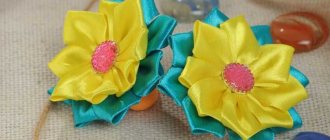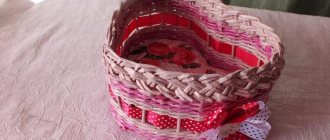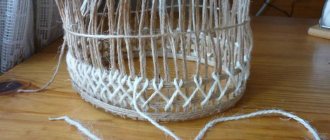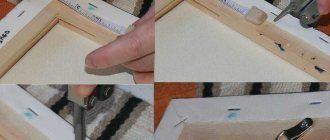A master class on weaving a vase from newspaper tubes will help you create a product with your own hands even for those who have never practiced this type of applied art. The finished work can be supplemented with flowers, sweets and fruits can be stored in it. A homemade vase made from newspaper tubes can be a pleasant gift for a loved one or colleague. Manufacturing does not require large financial costs or special skills, the main thing is the desire to create.
The photo shows various types of vases made from newspaper tubes.
A floor vase made of paper wicker can be used as an interior decoration, the production time can take from 5 hours to several days. An openwork vase can serve not only as decoration, but also perform certain functions - serve as a fruit bowl or a candy bowl. An openwork vase with high sides can serve as a container for storage of sweets, fruits or materials for handicrafts Products with ornaments usually perform only a decorative function - they complement the interior in an original way and attract the eye
Where to begin?
To master the weaving technique, you will need desire and a set of certain tools and materials. First of all, you need paper:
- a newspaper that has already been read;
- brochure of any store (not glossy);
- packaging of newsprint or office paper;
- cash register tape, etc.
Experienced craftswomen prefer to work with purchased newsprint, but regular brochures are also suitable for a beginner. Before twisting them, the material is cut into strips with a width of 7 to 10 cm. This depends on the knitting needle used in the work; the thicker it is, the wider the sheet of newspaper.
Additionally, you will need:
- It is a toe knitting needle, but it is advisable to use it with a thickness of 1 mm.
- PVA stationery glue or carpentry instant.
- Kitchen knife, sharpened.
- Scissors.
- Construction colors.
- Primer.
- Water-dispersed varnish.
- Braiding form.
- Decorative elements.
How to prepare a vine for weaving
The harvested vine can be stored in a cool, dry room for six months, then it will dry out and will not restore its elasticity even after soaking. The garage can be used as storage. The vine is hung or laid out on a wooden crate for better ventilation.
Willow branches can be used for weaving with bark or peeled. If you are going to weave a basket, vase, flower stand or garden furniture, it is better to first clear the bark from the willow twigs - the product will look more aesthetically pleasing. To make a wicker fence or arbor, cleaning is not necessary.
The bark is easily separated from willow twigs collected in spring. If you collected willow at another time of the year or do not use spring branches immediately, but after long-term storage, before removing the bark they need to be soaked in water for one to two weeks, or steamed for one to two hours. The vine is always used in its natural form; there is no need to peel it.
To clear the bark, use a special tool - a pincher. It is a slingshot made of wood or metal. The rod is placed in a fork, pressed and pulled along its entire length, the bark is separated.
Any vine in use should be as elastic as possible, then when weaving you can bend it at any angle without the risk of breaking it. To do this, before you start weaving, it is soaked in water. Finally, before starting work, the rods are sorted by thickness.
The brown inserts and different shades of the baskets were not achieved using paint. If you want to give a product made from peeled willow twigs a brown tint, you need to boil them for 40 minutes to 2 hours - the longer, the darker the product will be
Sequence of work
A beautiful vase made from paper tubes will not be made in a few hours, but the time investment is worth it. By following all the instructions, in the end, from under the hands of the craftswoman, a product will come out worthy of being exhibited in a museum.
How to weave from vines
It is best to learn weaving using the example of a specific product, for example, a basket. The work takes place in several stages.
Donyshko . To weave the bottom of a round basket you need to take an even number of thick rods. In half of them, a through cut is made with a knife in the middle, then you need to lay them out in a row and insert the second half of the rods into them. If you are going to weave an oval basket, the inserted rods need to be moved apart a little - so that the gaps between them are about 2-3 cm. The resulting cross from thick rods is sequentially braided with thinner ones using the “two-rod rope” technique. The result is the bottom of the basket.
How to start weaving a basket: creating the bottom of a round basket
The basis . You need to lay the sides of the future basket. An even number of thin rods is taken. They are inserted into the bottom one by one, forming a sun. Then the rods (rays) are bent towards the center and tied into a bundle - a structure in the shape of a ball or drop is obtained. This is the basis for future walls.
Several multilayer rows are woven around the bottom to give rigidity to the product. The “three-rod rope” technique is used.
How to make the base of a basket and strengthen the bottom
Walls . Now the base needs to be braided with vines to the height of the intended basket. A new rod is inserted horizontally under each vertical rod and snaked from left to right through all the warp rods in turn - the layer-by-layer weaving technique is used. Periodically, the layers need to be compacted - pressed towards the bottom of the basket so that the weaving is dense. When the desired height is reached, the rods of the walls are cut off, leaving the base behind.
How to weave basket walls
Top of the basket . In order for the basket to hold its shape well and not deform under load, its upper edge needs to be reinforced with denser weaving, as well as the bottom. You can get reinforcement using the base rods - they are bent to the side and intertwined with each other and additional rods. The technique is called “bending into three pairs of rods”
How to strengthen the top of the basket
Top decor . To give the basket some originality, the top edge can be finished with a braid.
How to decorate the top of a basket - the four-braid technique
Pen . The final stage of basket weaving is installing the handle. It is optional if you will not be wearing a basket. You need to take a thick rod, measure the required length, cut and sharpen the ends. Using an awl, you need to push the rods at the top of the braid of the basket and insert the workpiece into the resulting holes to a depth of about 5 cm.
Then thinner rods are taken and wrapped around the handle one by one - a stretched spiral of 4 - 5 turns is obtained. Thin rods are added until the handle is the desired thickness. At the end of the work, a lock is knitted from the ends of the rods to securely fasten the handles to the basket.
Installing the handle on the basket
Making newspaper tubes
To do this, cut newspaper sheets along the length of the spread into three equal parts (at least 7 cm). We select one of the sheets and place it in front of us, place a knitting needle on the corner and wind the paper onto it. At the end of the twist, a drop of glue is added, which will hold the finished vine together. We remove the workpiece from the working knitting needle and continue in the same spirit.
The angle between the knitting needle and the sheet should be made as small as possible.
The vine should not widen too much at one end and narrow at the other. Hollow tubes will also not give the finished product the desired appearance.
What types of weaving are there?
There are many varieties of wicker weaving, but most are formed by modifying the basic five weaving techniques.
Simple weaving. The rod with which the base is braided passes in turn, first in front and then behind the warp rods. When the thin twig ends, its end remains on the inside of the basket, and the weaving is continued with the next twig. Its beginning also remains on the inside, close to the previous one.
Layer weaving. Used for round products. The principle is the same as in simple weaving, but it is performed not with one twig, but with the same number of twigs, which makes up the base. Each rod in turn needs to take one step - go around it along the inside of the base rod and bring it out.
How to use layer weaving technique
A rope with two rods. Unlike simple weaving, you use two rods at the same time; they are also woven through one warp rod, towards each other, and each time the working rod is laid on top - as a result, they are additionally intertwined with each other.
How to weave a rope into two rods
Rope with three rods. Next to the three base rods you need to insert three rods. When weaving, the first of them passes through two warp rods on the outside and one warp rod on the inside. Then a second rod is taken and laid on top of the first in the same way. Do the same with the third one. And the cycle is repeated until the desired height is reached.
How to weave a rope into three rods
Spit . It is usually used to decorate the top of the product. Each warp rod is wound from the inside behind the adjacent one and laid sideways on the outside. One new twig is added to the first five warp rods and then all the rods are woven in pairs into a braid that goes along the top of the product.
How to make a side braid from a vine
Dyeing the vine
There is practically no universal composition for coloring newspaper tubes. Each craftswoman, by trial and error, selects the paint independently. The most commonly used stains are water or alcohol stains. It is better to work with the latter outside or on a balcony with an open window, as they smell strongly.
And also, “Richard’s cocktail” is in demand. To create it you will need:
- construction primer;
- color (color at your discretion);
- water based varnish.
All ingredients must be mixed in a 0.5 liter jar. First, 300 ml of primer is poured in, followed by three tablespoons of dye and 10 tablespoons of varnish. This is an approximate scheme for adding ingredients and it all depends on the desired color of the future product.
After the tubes dry, their color fades a little.
Recently, craftsmen often replace varnish with impregnation, claiming that it achieves the effect of gluing seams. You can paint several tubes at once with a brush.
You can dry the tubes with a hairdryer if you don’t have time to wait, or simply lay the painted vine on a plastic mat in a checkerboard pattern. This is necessary so that the tubes do not stick together and become moldy. You can see how to make a vase from newspaper tubes below.
What you need for weaving with wicker
You will need rods - material for the future product.
Depending on what you plan to make, you can use: · grapevine;
· willow twigs;
· hazel twigs;
· tropical rattan vine;
· bamboo.
Most often, preference is given to the vine and willow - they are the most accessible. Bamboo and rattan need to be purchased, and are often started after training on free vines.
You also need a small set of tools: a knife or pruning shears, pliers, an awl (possibly several of different sizes), a hammer, rubber bands or rope for fastening the elements of the work.
Most often, weaving starts from the bottom. If the product does not have a bottom (for example, you are weaving a wreath), use various templates. The base sets the shape of the product and helps weave evenly. Most often, round and oval shapes made of boards or plywood are used. Holes are drilled along the contour of the template, into which pegs are then inserted. Then the pegs are braided with vines.
How to create a universal pattern for weaving from wicker
Weaving the finished product
At the beginning, you need to choose a form for braiding, because without it a beginner will not be able to maintain the desired shape. For these purposes, any jar or bottle is suitable, which you can then leave in place and pour water into it.
Paper vine - master class
In order to quickly and efficiently weave any product from newspaper tubes, you must first stock up on these same tubes in sufficient quantities. And since they are the most important element in the whole work, they must be done carefully. Fortunately, the process is simple, and after the first ten tubes it will be brought to automaticity. The weaving technique is simple.
What you will need:
- PVA glue;
- Newspapers;
- Knitting needle of the required diameter;
- Scissors or utility knife.
First step. Disassemble the newspaper into sheets, lay out each spread, and put 7 cm pieces along the long side. Cut each sheet into these long strips. Someone uses a stationery knife, someone uses scissors - it doesn’t matter, the main thing is that the sheet does not have any jagged edges.
Second step. Place a strip of paper in front of you and place the knitting needle near the upper right corner of the newspaper. Start winding on the knitting needle from this angle. The tighter the paper is stretched, the denser and harder the tube will be.
Third step. Glue the tip of the newspaper with PVA glue to the tube. This tip should be slightly wider than the other. This is done so that later it is possible to “build up” the tubes, making the weaving continuous.
There is nothing complicated, but the task is monotonous. To make a full-fledged box or basket, you will need more than one newspaper, and more than one hour. Master classes never indicate the exact number of newspaper tubes needed for the craft, since it is impossible to calculate. Therefore, for work you always need to have a solid supply.
Crafts from palms: interesting applications and master classesModular origami dragon, Chinese dragon from modulesPaper plastic for beginners step by step: templates and diagrams DIY felt angels and patterns
Paper wicker products
Types of weaving
All weaves have a bottom and a frame base from which the pattern is built. Some people prefer to use thick cardboard as a base, gluing tubes to it to act as a frame. Someone forms the bottom from an interweaving of tubes. It all depends on skill and desire. For beginning craftswomen, it may be easier to deal with a cardboard base. There are quite a few options for weaving, they were all invented a long time ago, and there is nothing new in them. The most popular of them:
- Simple weaving is a good place to start for those who have never tried weaving with a vine before, but want to learn. There is a frame, and the frame tubes are braided as follows - the vine alternately passes under and above the frame.
- Spiral weaving is a more complex option; the base is braided in a spiral with two tubes, rising at a slight angle.
- Layer weaving - suitable for creating round crafts, it resembles simple weaving, but is done very tightly - that is, the frame bases should be located at a short distance from each other.
- Openwork weaving - it makes excellent decorative vases and baskets, the walls of which consist entirely of patterns. Schemes are used for weaving.
Master classes on these topics are quite popular, however, according to people who have been weaving for many years, having mastered the two basic principles of simple and layered weaving, it will not be difficult to modify any weaving in the future.
Photo of vases made from newspaper tubes
How to make decorative branches for a floor vase with your own hands?
In order to make the interior of your home original and individual, you don’t have to spend money on expensive designer items - it’s enough to use ordinary tree branches for decoration. Few people seriously think about this option, and in vain, because dry pods are a very beautiful and sophisticated material with which you can create original things for the home with your own hands.
Wooden rods will look great in any room, be it a living room, bedroom, kitchen, hallway or bathroom. They are great for decorating candles, decorating mirrors, creating an interesting cornice or hanger for things. You can even consider making decorative branches for a floor vase with your own hands. Here everything will depend solely on your imagination.
Processing branches for decoration
Before you create decor from branches for your home with your own hands, you should know that only dry branches are suitable for these purposes, otherwise you will have to dry them.
It is not necessary to use tree shoots in their original form; they can be:
- Paint with spray paint;
- Coat with wood varnish;
- Cover with enamel.
We offer you some interesting ideas on how you can use dry branches in the interior of your home. To do this, you don’t need any special skills - all you need to do is find beautifully shaped sticks.
Partitions in the room
An interesting and rather original screen for zoning can be made from equal length, even and well-dried branches. At the final stage, it is better to varnish the partition, so the finished product will acquire a certain charm.
Important! This zoning option will look not only very interesting, but also stylish. In the same way, you can make a screen in the bedroom from parts of the same size.
Headboard
The most important thing in the execution of such decor is to process the material well so that in the future it does not crumble on the heads of those who will sleep under it. You should also pay careful attention to the fastening of such decor so that when the mattress moves, the branches do not move in different directions.
Wall decor
Dry painted rods with a large number of branches will be a wonderful decoration for the living room, however, here are some points to consider:
- The main secret of this decor is that the rods should be of contrasting color to the wall.
- If the wall is dark in color, then the decoration elements should be either light or have a metallic sheen. If the wall is in a light tone, then it is advisable to use sticks of their natural color or painted in dark colors.
- It is also advisable to think about the lighting of such wall decor made from branches. For these purposes, you can use small candlesticks attached to sticks with glue, spotlights on the ceiling, or a garland wrapped randomly.
Important! It is thanks to the lighting that this original version of wall decor looks impressive and can turn an ordinary, discreet wall into a stylish part of the room.
Kitchen decor
Dry branches also look appropriate in the kitchen interior:
- Old, ugly batteries can be disguised with a screen of dry branches of the same length.
- Do-it-yourself eco-paintings, which can be quite large in size, will come in very handy in the kitchen.
- You can also make such a useful thing as a hot stand yourself from ordinary twigs.
- The trinkets on the refrigerator look original and very cute; they can be easily made from small shoots and then glued to magnets.
Non-standard and original design of the kitchen with twigs will help add a special atmosphere.
Bathroom decor
From simple dry branches you can make very practical decor in the bathroom - for example, it can be a beautiful shelf on the entire wall where you can store all kinds of bathroom accessories, or a ladder for towels.
Important! The sticks also look good and will serve as hooks - it’s convenient to hang bathrobes on them. You can also use a dry twig as a holder for a toilet paper roll.
Furniture
Dry branches and their cuts can be used in furniture decoration. Tables, the basis of which can be thick sticks, and the tabletop is made of transparent glass, look very stylish and elegant.
Important! Coffee tables and dressing tables can be covered with cuts from dry branches - they turn out not only beautiful, but also very comfortable.
Decorative lamps
There are so many different ideas for creating lighting fixtures. Lamps in which tree shoots of different diameters are used as a base look very beautiful.
Important! A thick, dry tree branch equipped with light bulbs will make any room more comfortable. This Eco-style element will perfectly complement a modern interior.
Shelves for storing small items
Quite practical and very cute shelves for storing souvenirs, books, jewelry and other small items can be very easily made using dry branches.
Such decor only needs to be well fixed on the wall and supplemented with finishing materials for decoration.
Important! A wooden trunk can serve as the basis for several shelves in the form of partitions.
Hangers
Their dry branches make beautiful and convenient wall hangers, as well as hangers. These can be not just knots that look like hooks on the walls, but also unusual floor and wall hangers for bedrooms and hallways.
Thus, thick sticks with branches can become convenient vertical hangers for clothes, while thinner ones can be placed along the wall.
Panel
To create such a decor requires a lot of energy, in contrast to the usual arrangement of a “bouquet” in a vase of branches. Initially, you need to come up with a composition, for example, a bird, a star or a heart, and then begin to implement it.
Pictures and frames
It’s not that difficult to make original and unique paintings from tree branches with your own hands. To do this, attach a composition of branches to the wall and surround it with a beautiful frame. You can decorate a photo frame with thin rods or their cuts, pasting it in a circle.
Important! You can decorate a mirror in the same way, which will look great on the wall in the hallway.
Branches in floor vases
Floor vases with dry branches look very stylish and impressive. Long branches standing in a transparent vase will perfectly replace any other decor and will attract attention.
Vase decoration
Decorative branches for a floor vase are a stylish way to decorate the interior of a room in Scandinavian and Eco-style. For these purposes, rods of their natural color selected from the ground can be used, however, if they are painted, they will look even more impressive.
Important! When starting to paint them, it is advisable to choose a color that matches the color scheme of the interior of the room. The most interesting and effective colors for these purposes will be black, white, silver and gold.
Such original vases with decorative dry branches will look good on coffee tables, shelves and bedside tables.
Video material
In conclusion, I would like to say that any decoration made from branches looks simply amazing, and most importantly, all decorations made from dry branches are environmentally friendly.
Share on social media networks:
serviceyard.net
What will you need to create such a product?
- newspaper tubes
- PVA glue
- craft kit (stationery knife, scissors)
- skewer, wire, knitting needle
- acrylic
- clear varnish
- brushes for painting
If you have never practiced this craft, then our article offers you step-by-step instructions for beginners. During the work you will learn the technique of quick weaving from a “rope”











